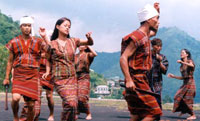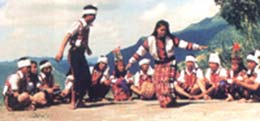| Encyclopedia of Tours and Travel to Mizoram, featuring information on Fairs & Festivals, Wildlife, Excursion, Adventure and Weather of Mizoram. |
 |
 |
 |
 |
 |
 |
 |
 |
|
|
Fairs & Festival
The traditional repertoire of festivals and folk and community dances offer visitors a delightful insight into the tribal heritage of Mizo culture in all its richness and variety. Surprisingly, some of the most popular dances like the Cheraw ( bamboo dance ), Khuallam, Solakia and Chheih Lam were never created for stage - rather they evolved out a spontaneous community spirit and participation. Festivals are called Kut in Mizo language.All the three festivals
are connected with agricultural activities. The festivals are celebrated
with feasts and dances. Chapchar Kut (March) is the three-day spring festival marked by singing and dancing and festive costumes by the tribals. Mim Kut ( August / September ) and Pawl Kut ( December ) are harvest festivals. Chapchar Kut The seven-day festival is usually held in the first week of March. This is when visitors get to see the local people in their rich ceremonial costumes. The traditional dresses, the jewellery, the exotic headdress and weapons worn by the representatives of each tribe showcases the most colourful aspects of Mizo culture in the finest tradition. Kut Puipate is the inaugural ceremony, which is followed by the Then Katna when the dancers get ready for the performance. The most important dance on the programme is the famous Cheraw or bamboo dance. Thalfavang Kut
This festival also depicts the cultural heritage and the traditional games of the Mizos. It has given an opportunity for the community to come together and renew old bonds and ties. Mim Kut Pawl Kut There is a legend regarding the origin of this festival. In the
olden days when the Mizos were living to the east of the Tiau river
in the chin hills, which is now in Burma, there was famine for thr It was customary for everyone to eat meat and eggs during Pawl
Kut. A few days before the day is fixed for the feast, the men would
go out hunting wild animals, trapping birds or fishing. One would
get as much meat as one's means would permit. Even the poorest would
kill at least a fowl for the household feast. As in Chapchar Kut,
mothers and children would gather together at the Lungdawh bringing
with them plates of rice, boiled eggs and meat and feed one another
performing Chhawnghnawt. The youngmen and girls would also attend
the Chhawnghnawt. The men would gather in the houses of well-to-do
persons and Zu would be drunk. The festivities were followed by
Eipuar Awm Ni or the day of rest. As Christianity spreads in Mizoram
these festivals gradually faded out.
|
||||||||||
|
||||||||||
|
||||||||||
|---|---|---|---|---|---|---|---|---|---|---|
 the most colourful renditions of the traditional Chapchar Kut (
Spring Festival ) are the ones organised by the Young Mizo Association
( YMA ) which has spearheaded the revival of old cultural traditions
in Mizoram. Each major village has a YMA branch so it is possible
to time a trip to watch this famous festival in all its traditional
pageantry.
the most colourful renditions of the traditional Chapchar Kut (
Spring Festival ) are the ones organised by the Young Mizo Association
( YMA ) which has spearheaded the revival of old cultural traditions
in Mizoram. Each major village has a YMA branch so it is possible
to time a trip to watch this famous festival in all its traditional
pageantry. ee
consecutive years. In the fourth year the people had a bumper crop.
The people believed that this was a blessing of the supreme god
and as a thanksgiving they celebrated Pawl Kut.
ee
consecutive years. In the fourth year the people had a bumper crop.
The people believed that this was a blessing of the supreme god
and as a thanksgiving they celebrated Pawl Kut.